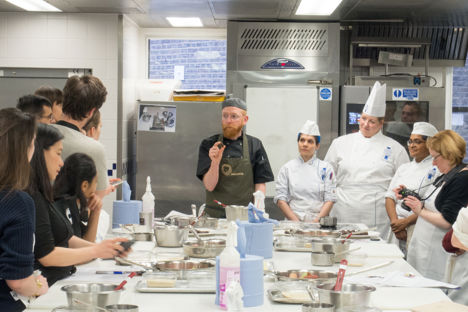
Cook school confidential: cooking with chocolate
We invited London's top chocolatier Paul A Young over to Le Cordon Bleu so he could demonstrate how to turn a few simple ingredients into a stunning dessert. See how the class got on and read his top tips for working with chocolate at home.
Cook school confidential: cooking with chocolate
We invited London's top chocolatier Paul A Young over to Le Cordon Bleu so he could demonstrate how to turn a few simple ingredients into a stunning dessert. See how the class got on and read his top tips for working with chocolate at home.
This year, Paul A Young celebrates his tenth anniversary of owning one of London’s most celebrated chocolate shops. His iconic purple packaging, innovative truffles flavoured with things like port and stilton or black pudding and Willy Wonka-esque shops attract sweet-toothed chocaholics from all over. We invited him to Le Cordon Bleu cookery school to host a Great British Chefs masterclass so he could share some of his expert knowledge.
The main aim of the class was to show people that cooking with chocolate at home is easy, and that all sorts of everyday ingredients can be used to add flavour. ‘The class is all about getting people to use chocolate at home,’ says Paul. ‘If you haven’t got one thing, you can usually substitute it for something else, and everyone has some spices in their cupboard. You only need a bar of chocolate and then you’re ready to go.’
Paul was keen to demonstrate a water ganache in his plated dessert – something that sounds quite complicated, but is actually relatively simple. ‘The general rule is to not get any water in chocolate, but if you dilute it quickly enough so it emulsifies together it works really well,’ he says. ‘I’ve chosen to make the ganache with a strong Earl Grey tea for its beautiful bergamot flavour, and sit the chocolate on top of vodka-poached rhubarb. To finish it off, I’ll be adding some white chocolate curls, rose petals and rhubarb syrup.’
Once everyone in the class had completed their own versions of Paul’s dessert, head pâtisserie chef Julie Walsh was on hand to demonstrate a Le Cordon Bleu classic – the Florentine. ‘They’re something you have after your dessert, usually with coffee, and they're just a nice way to end to a meal that’s honest, nice and quick,’ she says. ‘It’s a simple way to marry good quality dark chocolate with a nice fruit and caramel base.’
Paul's tips for working with chocolate at home
'Step up and spend more money. You cannot make crap chocolate taste or look good; it just won’t happen. You have to spend enough to make sure your chocolate doesn’t contain vegetable fats or anything else that doesn’t belong there. And don’t be attracted to shiny packaging – all those bars on the supermarket shelf that are wrapped in foil and have all the right words on there to suck you in probably aren’t that great. Just look at the ingredients – there should be cocoa beans, sugar, natural vanilla and sometimes soya or sunflower lecithin, nothing else.'
'Open your storecupboard. Everyone has something at home they can add to chocolate whether it’s spices, herbs, condiments, salt or pepper. Look in your alcohol cupboard, too; you don’t have to stick to the liqueurs. You can make a water ganache out of whisky, sherry or red wine – just changing that one ingredient will completely transform your recipe.'
'Don’t spend your money on lots of equipment when you’re starting out. All you need to master the basics is a wooden spoon and a mixing bowl. Once you can temper chocolate, you can mould, sculpt, curl and shard, and all you need is a bowl or a small granite slab which you can get from Argos for less than £10. When you’ve mastered tempering, you can move on to other things.'
'Buy some books or go on a course to see just how simple it can be to cook with chocolate. It’s been intimidating for so many years but people are starting to realise it can be easy. It’s a bit like macarons – for years it was a secret until they did it on Bake Off and now everyone’s making them. It can be frustrating to get things right in the beginning and you won’t get it overnight, but you’ll nail the techniques soon enough.'
'Touch and feel chocolate when you’re working with it. Analyse the temperature and the taste – if it’s grainy then it’s probably not right, if it’s oily then it’s probably split and if it tastes burnt then it probably is. Chocolate is one of the only foods that melts at body temperature, so as humans we’re very in tune with it. The cocoa bean is so different from what we call chocolate, but you don’t want to change it too much. Keep it true to its flavour and when you’ve got the basic skills sorted just keep playing around with it.'


